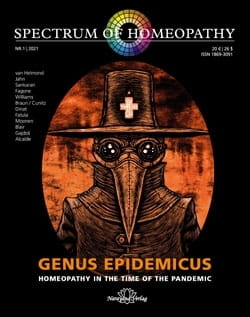Genus Epidemicus - Spectrum of Homeopathy 2021/1
In the last year we have been confronted with a new virus that has exposed a series of weaknesses in our social and individual lives. Spanning areas as diverse and fundamental as politics, economics, health and education as well as for each of us in our daily lives, our families and relationships, the pandemic has turned into a never-ending stress test. Homeopathy must also prove itself in the light of these challenges posed by a multifaceted illness with very varied progression.
One year into the pandemic we can now see that a distinct genus epidemicus, as often found in flu waves, cannot be identified. This was also true of Spanish flu, as described in the article “Pandemic Déjà-Vu”. Exactly as then, the genus epidemicus is to be found in a remedy pool including remedies such as Bryonia, Gelsemium, Eupatorium and others. Bryonia alba is used around the world most often – it not only embodies the symptoms of many of those who fall ill with Covid-19 but also has the existential fear associated with the coronavirus crisis. We hear this confirmed from places as far apart as New York and Milan.
We have received numerous contributions straight from the pandemic hotspots by colleagues in northern Italy, the US, Russia, South Africa, Spain, India, Belgium and the Netherlands. These are moving accounts which convey the terror of this illness as reflected in the individual fates of the people affected. At the same time they instil hope – such as the story of how eleven elderly (around the age of 80) SARS-CoV-2 positive nuns in a South Tyrol convent survive the infection with homeopathic treatment.
At the same time they instil hope – such as the story of how elderly members of the Hasidic community in Brooklyn survive the infection with homeopathic treatment.
Although it is often too difficult to assess the effect of remedies in such a varied illness with a large percentage of harmless infections, our authors describe many examples with rapid improvement and enduring recovery thanks to homeopathic treatment. In most cases this helps us reach the goal of preventing the illness progressing to a more serious form requiring hospitalisation. In this way homeopathy can, if used in the initial stages of Covid-19, make a significant contribution to minimising the critical treatment bottleneck found in the pandemic. This is also true of the frequently protracted illness seen with long Covid or post-Covid syndrome. Along with constitutional remedies, the genus epidemicus remedies can play a key role here.
In addition to the polychrests from the remedy pool mentioned above, many of our authors describe good results with less wellknown remedies such as Adamas, Grindelia, Lobelia purpurascens or Bothrops lanceolatus. Remedies such as Abrotanum or Radium bromatum were selected via plant theory or the periodic table, and those homeopaths favouring modern methodologies often state that the genus epidemicus should not only reflect the symptoms of Covid-19 but also signify the global zeitgeist and the current state of planet earth. So issues such as social distancing and isolation belong just as much to Camphora and the Magnoliidae subclass as also to the AIDS miasm with Ozone, the fungi remedy Cryptococcus neoformans and the radioactive Actinides. There is a striking two-fold connection between the human illness and the planetary crisis in relation to the global-warming gases Ozone and Carbon dioxide with their clinical focus on the airways. A collection of 34 Covid-19 cases thereby confirms the hypothesis that Carboneum dioxygenisatum is an important epidemic remedy.
In homeopathic practice there are many colleagues who are not so much concerned with the actual illness Covid-19 as with the psychosocial side effects and wider consequences of the entire coronavirus crisis. Those not working in a hotspot see relatively few infected patients but rather people suffering anxiety, fear, paranoia, depression, overload and burnout, often with a raft of accompanying psychosomatic symptoms. The contribution on “Morbus Lockdown” can only provide an initial impression of this aspect, which we will likely encounter in various guises for many years to come. Similarly this entire issue on the genus epidemicus can only show a small subset of the responses by homeopaths around the world to this global state of emergency, while many countries remain in lockdown. How homeopathy performed in this unprecedented stress test and whether it rose to the occasion to demonstrate what it can achieve will hopefully become clear in the not-too-distant future.
- Author: Narayana Verlag
- ISBN: No ISBN
- 96 pages
- Paperback
- Published in 2021
- Printed in Germany

